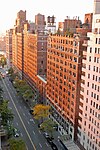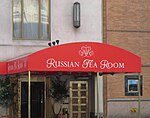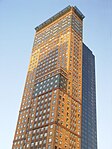130 West 57th Street

130 West 57th Street is an office building on 57th Street between Sixth Avenue and Seventh Avenue in Midtown Manhattan in New York City. It was built from 1907 to 1908 and designed by Pollard and Steinam, who also simultaneously designed the neighboring, nearly identical building at 140 West 57th Street. The buildings are among several in Manhattan that were built in the early 20th century as both studio and residences for artists. 130 West 57th Street is fifteen stories tall, with fourteen stories facing 57th Street, as well as a penthouse. The lowest two stories of the primary facade along 57th Street are clad in limestone, while the upper stories are clad in brick. The facade contains both broad and narrow bays with metal-framed studio windows, some of which are double-height. Along 57th Street, there are cornices above the second and fourteenth stories. There were double-height studios on the 57th Street side and smaller residences at the back of the building. 130 West 57th Street was developed upon land owned by artist Robert Vonnoh. Although marketed as artists' studios, 130 West 57th Street was also home to lawyers, stock brokers, teachers, and other professionals. The building was converted into a rental-apartment structure in 1937, and was subsequently converted into an office building during the late 20th century. 130 West 57th Street was designated a city landmark by the New York City Landmarks Preservation Commission in 1999.
Excerpt from the Wikipedia article 130 West 57th Street (License: CC BY-SA 3.0, Authors, Images).130 West 57th Street
West 57th Street, New York Manhattan
Geographical coordinates (GPS) Address External links Nearby Places Show on map
Geographical coordinates (GPS)
| Latitude | Longitude |
|---|---|
| N 40.76467 ° | E -73.97868 ° |
Address
West 57th Street 130
10019 New York, Manhattan
New York, United States
Open on Google Maps









